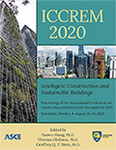International Conference on Construction and Real Estate Management 2020
International Market Selection of Chinese Construction Companies from the Perspective of Cultural Distance
Publication: ICCREM 2020: Intelligent Construction and Sustainable Buildings
ABSTRACT
Chinese international contractors (CICs) are gaining competitive edge in the international contracting market by applying the “going out” strategy and the “Belt and Road” initiative. They contract projects in more than 180 counties and regions worldwide. The cultures of these countries differ largely from each other and from China. Based on the industrial practices of CICs, the present study examines the potential correlation between cultural distance and market selection of international contracting. The definition and dimensions of cultural distance in international contracting are elucidated and the cultural distance between the host country and China are measured. The turnover of CICs measured by countries and regions refers to China’s statistical yearbook, and the data are analyzed through regression analysis. The present study draws contractors’ attention to consider international market selection in terms of the cultural distance as part of their global expansion strategy.
Get full access to this article
View all available purchase options and get full access to this chapter.
ACKNOWLEDGMENTS
This study has been supported by the Young Teacher Development Fund 011350319003 by Central University of Finance and Economics. The authors gratefully acknowledge the School of Management Science and Engineering at Central University of Finance and Economics for providing technical support to conduct this research.
REFERENCES
Andersen, O. and Buvik, A. (2002). “Firms’ internationalization and alternative approaches to the international customer/market selection.” International Business Review, 11(3), 347-363.
Bilkey, W.J. and Tesar, G. (1977). “The export behavior of smaller-sized wisconsin manufacturing firms.” Journal of International Business Studies, 8(1), 93-98.
Chen, C., Wang, Q., Martek, I. and Li, H.J. (2016). “International market selection model for large Chinese contractors.” Journal of Construction Engineering and Management, 142(10), 04016044.
Engineering News-Record (ENR) (2019). “Top 250 international contractors.” <https://www.enr.com/toplists/2019-Top-250-International-Contractors-1> (Dec. 5, 2018).
Eybpoosh, M., Dikmen, I. and Birgonul, M.T. (2011). “Identification of risk paths in international construction projects using structural equation modeling.” Journal of Construction Engineering and Management, 137(12), 1164-1175.
Gao, R., Chan, A.P.C., Lyu, S., Zahoor, H. and Utama, W.P. (2018). “Investigating the difficulties of implementing safety practices in international construction projects.” Safety Science, (108), 39-47.
Gao, R., Chan, A.P.C., Utama, W.P. and Zahoor, H. (2017). “Workers’ perceptions of safety climate in international construction projects: effects of nationality, religious belief and employment mode.” Journal of Construction Engineering and Management, 143(4), 04016117.
He, X., Brouthers, K.D. and Filatotchev, I. (2018). “Market orientation and export performance: the moderation of channel and institutional distance.” International Marketing Review, 35(2), 258-279.
He, X., Lin, Z. and Wei, Y. (2016). “International market selection and export performance: a transaction cost analysis.” European Journal of Marketing, 5(50), 916-941.
Hofstede, G. (1991). Cultures and organizations: software of the mind, McGraw Hill, New York.
Hofstede, G., Hofstede, G.J. and Minkov, M. (2010). Cultures and organizations: software of the mind, McGraw Hill, New York.
Kang, B.G., Zhang, C., Randunne, S.D., Goh, B.H. and Song, M.K. (2016). “An investigation into cultural dimensions of construction professionals working for international projects in Oman.” International Journal of Engineering and Technology, 8(2), 982-987.
Mearns, K. and Yule, S. (2009). “The role of national culture in determining safety performance: challenges for the global oil and gas industry.” Safety Science, 47(6), 777-785.
O’Grady, S. and Lane, H.W. (1996). “The psychic distance paradox.” Journal of International Business Studies, 27(2), 309-333.
Ofori, G. (2003). “Frameworks for analyzing international construction.” Construction Management and Economics, 21(4), 379-391.
Papadopoulos, N. and Martín, O. (2011). “International market selection and segmentation: perspectives and challenges.” International Marketing Review, 28(3), 3-9.
Ye, K., Lu, W. and Jiang, W. (2009). “Concentration in the international construction market.” Construction Management and Economics, 27(12), 1197-1207.
Information & Authors
Information
Published In
ICCREM 2020: Intelligent Construction and Sustainable Buildings
Pages: 758 - 765
Editors: Yaowu Wang, Ph.D., Harbin Institute of Technology, Thomas Olofsson, Ph.D., Luleå University of Technology, and Geoffrey Q. P. Shen, Ph.D., Hong Kong Polytechnic University
ISBN (Online): 978-0-7844-8323-7
Copyright
© 2020 American Society of Civil Engineers.
History
Published online: Oct 14, 2020
Published in print: Oct 14, 2020
Authors
Metrics & Citations
Metrics
Citations
Download citation
If you have the appropriate software installed, you can download article citation data to the citation manager of your choice. Simply select your manager software from the list below and click Download.
